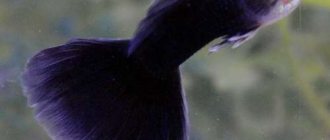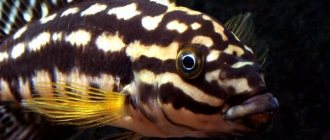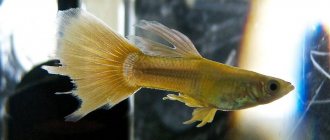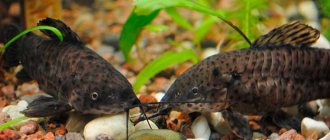Nature has given us pets that vary in shape, color, size, and habits. Unfortunately, fish cannot always live together in the same aquarium. Therefore, when choosing “settlers”, be guided by information about the compatibility of aquarium fish. You can use the compatibility table: just know the names of the fish, and the table will clearly show how good they will be together. But it is better to study information on each type separately.
Why is compatibility so important?
Some fish can live at home for up to 8-10 years. In order for them to reach this age, the requirements for their content must be taken into account:
- The difference is in the conditions. This includes temperature, feeding regime, food, and water parameters. Some fish need cold water no higher than 23°C, others need warm water, from 26°C. Some require strong aeration, others cannot tolerate any movement. The aquarium environment can be neutral, alkaline or acidic. Even soil requirements vary.
- The difference is in the characters. Those fish who live without stress have a long happy life. If you add an evil predator to a peaceful breed as a neighbor, the fish will only have to look for shelter and save its life. The predator will not be able to find peace until it reaches its prey.
- Behavior. Slow fish with veil fins and long rays are not compatible with their fast, playful neighbors. Nimble fish will bite and tear off lush decorations in a maximum of a week.
- Fish prices. An important factor. Many specimens cost a lot, so it is important to consider their compatibility with other fish. So that the story does not turn out to be when neighbors brought a fish worth several thousand rubles to death in a couple of weeks.
Gourami
These tropical labyrinth fish are loved by many aquarists; they are active, peaceful and do not require complex care. But males of this breed often start fights with their own kind, so keeping them in a common container is encouraged.
Gourami get along well with non-aggressive small, non-territorial fish. They get along well with angelfish and rainbow melatenia. But living with a cichlid, betta, goldfish, brocade carp or astronotus will not benefit friendly gourami.
Types of compatibility
There are fish:
- Fully compatible;
- Completely incompatible;
- Category “at your own risk”.
Everything is clear with the first two. What is the third category, and how to deal with it?
Much depends on the conditions, the owner’s experience and his attentiveness. For example, if the fish do not exactly match each other in character, but live in a large aquarium where there is enough space for everyone, their proximity is considered acceptable.
Another indicator of conditional compatibility is life in different layers of water. Some fish live mainly at the surface, others at the bottom. Still others occupy the middle layer. Bottom-dwelling fish almost never touch those living near the surface. Even if catfish are predatory, and their neighbors are peaceful and small.
Intraspecific compatibility. For some species, it is important that there are fewer males than females. If this condition is not met, the fish will fight until their number becomes comfortable.
Loaches
The loach family consists of three dozen genera and just under 200 species. Most representatives are nocturnal and hunt in the dark. During the day, they hide in the thickets or bury themselves in the sand.
Not all representatives of the species have been well studied, but it is known for sure that they get along well with pleco catfish. Otherwise, you should take into account the size of the aquarium and the individual character traits of each individual.
Four main rules of compatibility
You cannot room together:
- Peaceful with predators;
- Large with small;
- The fast ones with the slow ones.
It is on this basis that all compatibility tables are based (they do not take into account water parameters).
The fourth rule is that it is better not to introduce newcomers into an established team. If you decide to diversify the tank with fry, be careful: old-timers can quickly get rid of them. The idea of placing adults with adults is also not the most successful: it is unknown how a newcomer will join the team.
Guppy
Many aquarists begin their acquaintance with the aquarium business by breeding these small, viviparous fish. Guppies are tenacious, easily tolerate any changes and are prolific. They develop quite good neighborly relations with other livebearers from the poeciliaceae family - mollies, platypecilia, and girardinus.
Swordtails often chase guppies and eat their fry, so such a neighborhood is possible if the guppies live in a spacious tank with abundant vegetation. Angelfish usually do well with angelfish until they grow into adults. In this case, it is 50:50 that they will not consider small neighbors as food.
All large or medium-sized predatory fish perceive guppies as food, and nothing can be done against nature. Sooner or later, the owner will run out of fish, and soon won’t find any at all, if cichlids, loaches, carps, and macropods live in the aquarium with them.
Peaceful fish: compatibility
Peaceful fish include small fish up to 8 cm in size, which do not have sharp teeth and a grumpy character.
Angelfish
Quite slow representatives of cichlids. Predators, but peaceful. However, these fish are unpredictable: some individuals can even get along with guppies, others do not tolerate anyone at all as neighbors and kill everyone who could not fight back.
Barbs
There are many varieties of barbs. They are all very active by nature, love fast currents, and require room to swim. This is a schooling fish, and in a spacious aquarium it can coexist with almost any non-aggressive neighbors. For large predators this is food.
Goldfish
Cold-loving fish, their ability to reproduce and life expectancy depend on temperature. The ideal aquarium is a monospecies one, which combines different types of goldfish.
Neons
They can be food for any fish. They are usually kept in a large flock, so they look especially beautiful swimming in the water column. It is not recommended to introduce anyone other than catfish to them. Even if a flock of neons lives well in the company of barbs or swordtails, rest assured that over time their number will decrease. This means that neighbors sometimes hunt for defenseless neons out of boredom.
Guppy
They get along well in spacious aquariums with non-aggressive fish of the poeciliaceae family of the same size. Swordtails, mollies, and platies will be suitable neighbors. It is not recommended to be introduced to any predators, including barbs and angelfish.
Discus
Slow and timid fish require high-quality water. Because of this, they rarely get along with anyone. Barbs are too fast for them, goldfish are too dirty. In addition, discus prefer warm water; rare fish can withstand their comfortable range of 27-30°C. By nature, although they are slow, they are still predators. In short, discus are fish for a mono-species aquarium.
Cardinal, zebrafish
You can offer guppies, minors, macropods, rasboras, tetras, and swordtails as neighbors. Danios and cardinals are non-aggressive and have no means of self-defense. You should not add goldfish, angelfish, not to mention cichlids.
Ternetia
Ternetias can get along with equally peaceful but active fish. Swordtails, tetras, gourami, and catfish are suitable neighbors. Fish with veil fins and long rays (angelfish, bettas) are not recommended. Defenseless species like neons, guppies, and zebrafish are also not suitable.
Bocia
Schooling fish are on their own. Almost any non-aggressive and moderately aggressive fish that are comparable in size and do not have lush fins or rays will be suitable neighbors. Keep in mind that it is more difficult for new bots to accept them, so if there is only one old bot left in the aquarium, just love it. Most likely, she will not tolerate anyone in her home.
Lyalius
Lalius is a peaceful, calm and shy fish. The same leisurely neighbors will suit the company: rasboras, swordtails, platies. Guppies and barbs are not recommended. Vanity in the water will keep the lalius in constant tension, which means it will shorten its lifespan. Lyalius vitally needs plants as shelter. Therefore, fish that like to feast on aquarium vegetation are not suitable.
Gourami
A peaceful fish that can theoretically be added to any calm neighbors: platies, swordtails, rasboras. However, gouramis have long rays on their fins, so they will not get along with “jewelry hunters”, such as barbs.
Apistograms
An active representative of small cichlids, does not fight for territory, does not dig up plants, but can be aggressive towards those who do not like it. You can keep with them small, peaceful fish that can fend for themselves: guppies, swordtails, rasboras, rhodostomus, barbs, angelfish.
Koi carp
Fish living in ponds and spacious aquariums. In such conditions, other fish will be uncomfortable.
Labeo
A fish with a complex character that deteriorates with age. It's useless to hook someone up. Young labeos can be populated simultaneously with fish that live in the upper layers of water and do not sink to the bottom: angelfish, barbs, tetras. The neighbor must move quickly and not provoke conflict situations.
Ornathus
The fish is similar in taste to neons, rasboras, and guppies. Ideal neighbors are the ornathus themselves and most peaceful small catfish. In addition, tetras, platies, pulcheras, and swordtails are suitable for keeping together.
Cockerel
The temperament of these fish is harsh, males are aggressive towards everyone: strangers, females, each other. Even catfish can get it. In large aquariums, neighbors are possible, but cold-loving fish, fish with lush fins and long rays, guppies, barbs, and neons are not suitable. You can try swordtails, mollies, gourami, tetras, rasboras, minors, and catfish.
Pristella
Peaceful, shy schooling fish. Gets along with calm swordtails, rasboras, and tetras in a large aquarium. It is recommended to create a monospecies biotope in smaller volumes.
Rainbow
A fast, peaceful fish that gets along well with equally active species, such as barbs.
Rasbora
Peaceful predator. Ternetias, rhodostomuses, minoras, guppies, platies, and mollies are suitable neighbors.
Corridors
They are also shellfish and are considered one of the most peaceful and friendly aquarium inhabitants. These catfish do not bother other inhabitants and tirelessly pick up scraps, clearing the tank of debris, which further increases their popularity among aquarists. Their habitat is the bottom, so they practically do not overlap with their neighbors living in the middle and upper layers.
You can place shellfish in:
- scalars;
- barbs;
- betta fish;
- zebrafish;
- discus;
- gupeshkas;
- boots;
- mollies;
- platies;
- catfish pleco;
- melanothenia;
- rasboram.
It is not recommended to place large and medium-sized predators with shellfish: cichlids, goldfish, koi carp, astronotus.
Cichlid Predators: Compatibility
Those who are definitely not suitable neighbors for any fish from the list above. Cichlids are hunters, fast, strong, they can fend for themselves and are jealous of their territory.
Akara
A calm predator up to 12 cm in size, it gets along with American cichlids. In spacious aquariums they are successfully kept even with astronotuses and parrots. It is not recommended to introduce African cichlids.
Astronotus
A very large predator with a fairly calm disposition, but not one to be offended. In large aquariums it lives with South American cichlids, chromis, and cichlasomas. All small fish are considered as food. The classic combination of astronotuses is with parrots.
Pseudotropheus
Aggressive predators even towards each other. One male for several females. Neighbors can only have Malawian mbuna cichlids. Requires a lot of cover.
Piranhas
Despite the fact that at home these fish are much calmer than in nature, they are kept only with their own kind.
Discus
These fish, originally from the Amazon River, have an unusual rounded and flattened body shape, reminiscent of a disk, for which they are called discus. They are non-aggressive, not prone to showdowns and can keep company with the following aquarium inhabitants:
- shellfish;
- zebrafish;
- mollies;
- platies;
- catfish pleco;
- iridescent melatenia;
- Rasbora fish;
- swordtails;
- Ramiresi's apistograms;
- red tetras.
Discus fish should not be housed with angelfish, barbs, cockerels, goldfish, guppies, koi carps, or astronotus.
Discus and neons get along well and look great in the same tank, but the latter live less in warm water, which is suitable for discus. In addition, they should be housed together when they are juveniles, otherwise larger disc fish will shamelessly eat small inhabitants.
Another nuance that is worth considering is that discus move slowly and imposingly, so they can starve due to more nimble and voracious neighbors. Many aquarium owners prefer to keep only discus fish, and indeed a flock of 6-8 individuals can fully decorate an aquarium without other inhabitants.
Catfish and bottom fish: compatibility
It is believed that the catfish will not bother anyone, but will take care of the aquarium. It is unknown who and when this story was invented. In practice, everything is somewhat different.
Ancistrus
Quite large catfish, about which it is difficult to say anything unambiguously. Like angelfish, a lot depends on the character of the individual. The young Ancistrus is busy with itself and can get along with almost any fish. The older the fish, the more difficult it is to accept new neighbors. You may not like anything: a playful disposition, a veil fin and other features. Recommended as a bottom companion for cichlids.
Corydoras or speckled catfish
Small fish, not protected by a shell, which sometimes need to float to the surface to swallow an air bubble. They coexist with barbs, goldfish, zebrafish, guppies, swordtails, angelfish and even neons. A rarity for catfish, Corydoras love to live in a flock of their own kind.
Catfish tarakatum
An inactive predator, it can eat small fish, so it is not recommended to keep it with guppies, zebrafish, etc. A good neighbor for angelfish and small cichlids.
Barbs
These representatives of the large carp family captivate with their bright colors, liveliness, variety of species and undemanding nature. But at the same time, barbs are extremely mobile and are predators, so it is not recommended to put them in the same tank with fish that are unable to fend for themselves.
The following inhabitants can fight back against overly assertive neighbors:
- angelfish;
- zebrafish;
- gourami;
- carapace;
- botia;
- mollies;
- pecilia;
- Plectomus catfish;
- melanothenia;
- analysis;
- labeo;
- swordtail;
- tetra.
If barbs begin to actively terrorize representatives of the above breeds, it is worth thinking about moving all the inhabitants into a larger container or providing the brawlers with separate “housing.”
It is difficult to predict the behavior of these cyprinids, so most often everything becomes obvious only in practice. But it is known for sure that the following fish are absolutely not suitable as neighbors for barbs:
- cockerels;
- South American and African cichlids;
- brocade carps;
- astronotuses.
Discus, loaches and guppies in some cases get along well with barbs, but, again, the individual characteristics of the latter matter.
Other representatives of the underwater world
Exotic inhabitants - such as crayfish, eels or shrimp - can be difficult to keep with ordinary fish. It is better to keep crustaceans and turtles in a separate tank specially designed for them.
Cancer
They can be aggressive towards their neighbors, but during the molting period they themselves become prey.
Shrimps
Like any mollusks, the smaller it is, the more defenseless it is. A small shrimp can even be placed with neons, since they live in different layers of water. Large shrimp are kept without fish.
Goldfish
It is best if these representatives of the crucian genus live only with their fellows - they are comfortable, comfortable and safe. Actually, even alone, the goldfish will not be bored. But if the owner still wants to place the goldfish in a common tank, you should be careful:
- they do not get along well with cichlids, often due to the aggressiveness and high territoriality of the latter;
- in the company of labyrinthine fish, golden ones are unlikely to be calm - violent clashes, most likely, will not happen, but gourami or lalius will get at the phlegmatic crucian carp. It is possible to get along with ctenopomas - but only if the golden ones do not irritate them with their habit of rummaging in the ground;
- goldfish will consider small inhabitants only as food, so you should not introduce them to neons, rhodostomuses, and minors;
- if proximity is inevitable, then it is advisable to choose larger and less nasty fish, for example, diamond tetra or congo.
In the company of Sumatran barbs, goldfish will not look good - “Sumatrans” have a weakness for the luxurious fins of goldfish and do not miss the opportunity to give them a good pat. Ornamental crucians can get along with brocade carp, but the cute Koi are able to do without any roommates - they are completely self-sufficient and can decorate an aquarium alone.
It is recommended to add tarakatum and corydoras catfish to the scrofulas, as they will clean up the garbage behind the not-so-clean crucian carp.
Basic principles of good neighborhood
Before you run to the pet store to buy new pets, you need to carefully study their maintenance requirements and compatibility with other fish.
- The inhabitants of the same aquarium should have similar requirements for temperature and water hardness, the presence of flow and aeration.
- The type of food the fish have should be similar.
- Do not add overly active fish to calm and slow-moving individuals. The latter will become a constant source of stress for sedentary fish.
- The size of the fish should not differ significantly. Large individuals will inevitably begin to oppress the small ones and deprive them of food.
- It is advisable to introduce all inhabitants into the aquarium at the same time. Otherwise, the old inhabitants of the vessel may drive out the newcomers.
- It is necessary to pay attention to the volume of the aquarium without overcrowding it. The minimum volume of water per guppy is 2.5 liters, but it is better to stick to a volume of 5-7 liters per head.
- The fish house should have enough live or artificial plants, pebbles, and driftwood. Small fish, including guppies, love to hide there to rest.
Among aquarium fish there are enough individuals that can share the same home with guppies. But an aquarium inhabited by only one species of fish will look no less colorful.
Reproduction of catfish
For breeding armored catfish, an aquarium from 30 to 70 liters is suitable - a spawning tank. If the aquarium is a species aquarium, then you can breed catfish directly in it. The spawning tank is equipped with snags and plants. Lighting should be dim, twilight. Enhanced aeration of the aquarium is also provided.
The spawning ground can be without any soil or plants at all, with natural light.
It is worth maintaining the water temperature from 17 to 25°C, and it should be non-acidic and clean. Two to three males are recommended for one female; if there are several females in the spawning tank, there should be 1.3-1.8 times more males.
To stimulate spawning the following is done:
- changing the temperature regime in the aquarium, increasing or decreasing the temperature by 2-3°C per day, in the range from 17 to 25°C;
- changing water up to 50% of the total volume of the spawning tank for 2-3 days (once a day);
- enhance aeration and purify water with air.
The composition of the water in the spawning area is not much different from the main composition for permanent residence. The main thing is that the acidity is neutral. Water with a temperature of 18 to 20°C is considered the most favorable for reproduction. The female becomes suitable for new spawning after 7-10 days.
In chain-mailed catfishes, reproduction occurs in a slightly different way. Males of this family are territorial, so they are kept separately, with 1-2 females placed with them. Inverted flower pots, grottoes, caves, and driftwood are used as spawning grounds. The male thoroughly cleans his “apartment” and then invites the female to spawn. If she is satisfied with the home, she spawns 20-100 large yellowish eggs, which are immediately fertilized by the male. After spawning, he drives it away and continues to independently care for the offspring, maintaining cleanliness, fanning the clutch with fins and removing dead eggs.
Catfish synadontis.
How does mating happen?
The courtship period lasts 7-10 days, during which the male demonstrates himself in all his glory from all sides. He tries to arouse the female's interest and curiosity by circling around her and following her closely. When the female shows favor, she allows her to be touched with her antennae, showing her readiness to reproduce the species.
The male holds the female's antennae with his pectoral fins and body. At the same time, it produces eggs in its pelvic fins (folding them, forming a container for the eggs), 1-5 pieces each. and at the same time takes the male’s milk into his mouth, after which he selects a place for spawning (plant leaves, flat bottom stones, aquarium glass). The female catfish removes the laying area and cleans it, after which, lubricating it with milk, she carefully lays out the eggs. The caviar is large, from 1 to 2 mm, a single clutch consists of 50 or more eggs (up to 200, depending on the size and type of fish).
Gerinocheilus effectively destroys unwanted vegetation, but at the same time it is an extremely aggressive neighbor.
Caring for fry
After spawning, the parent catfish are placed in a common aquarium, and the water temperature in the spawning area is maintained at 19-21°C, while natural lighting is left or the spawning area is slightly shaded. 8-12 days after laying, the larvae emerge from the eggs and then eat the residual yolk sac of their previous location.
It is recommended to feed the fry with ciliates or dry food for fry (specialized or regular, crushed into dust). After 7-10 days, the diet can be expanded with brine shrimp, nematodes or crushed other live foods (bloodworms, tubifex).
Fry of chain catfish are fed with grated egg yolk, scalded rolled oats, lettuce and chopped green peas.
The adult coloration of the fry is formed after eight weeks and completes its formation on the tenth; then during life it changes slightly.
Catfish reach sexual maturity at the age of 8-12 months.
Due to the large number of catfish species, many hobbyists assume that the conditions for all catfish are the same, and the fish becomes a victim of improper care. Before purchasing catfish, it is extremely important to study reference literature on the species being purchased. Each of them requires individual care and maintenance, although in comparison with other representatives of the aquarium they are unpretentious and undemanding.
Video: catfish divide territory.
Many fish lovers prefer to keep small species: guppies, cyclids, swordtails, gourami, labio. But there are also those who will happily fill the vessel with large inhabitants, such as catfish. It is a mistake to think that this type of fish is found only in reservoirs. Experts have bred dozens of species that have taken root in limited spaces. Catfish will not only decorate the aquarium, but also clean it of everything unnecessary. Experts call them “scavengers.” They utilize leftover food, excess algae, mucus and waste from other fish.
Aquarium catfish are quite large in size. They spend most of their time at the bottom, so comfortable living conditions must be created for them. In the article we will talk about aquarium catfish, species, conditions of their keeping. If you want your fish to feel comfortable and not get sick, carefully study the information.
Adviсe
- There are species whose character changes as they grow older. For example, some catfish become territorial.
- Study the information yourself. The advice of others is not always correct. Find more information about your fish.
- The large number of fry and snails is regulated by the settlement of large neighbors.
Fish compatibility is a point that needs to be studied when becoming an aquarist. It is also important to know about fish nutrition, lighting, starting an aquarium and changing water parameters.
(Visited 4,754 times, 1 visits today)
When combining fish in an aquarium, aquarists make the following mistakes:
- Overpopulation . Every pet must live in appropriate conditions. Under no circumstances should you create a “communal apartment” from a can. In it, pets will divide the territory, fights and injuries will begin, which will lead to death.
- Improper conditions of detention . Each type of fish requires certain conditions of detention. For example, for comfortable living, loaches need fine soil or even sand. They love to burrow in it. If the soil is large, the fish may get injured trying to dig in. In an aquarium with angelfish, it is recommended to divide the territory with the help of plants, such as Vallisneria. Ancistrus definitely need shelter. It could be driftwood, coconut or a variety of plants.
- Don't forget that you are responsible for the lives of your pets. Poor living conditions lead to death.
Akara
Dangerous for plants and small fish. Keeping in a school or solitary.
Ancistrus
Lives alone. Sometimes Ancistrus competes with bottom dwellers for territory.
Apistogram
Aggressive during spawning. It settles alone or in a group of a male and 2–3 females.
Astronotus
Calm view. Compatible with fish of comparable sizes. Do not place with small fish, such as guppies and neons. Astronotuses perceive them exclusively as food. Plants are destroyed. Content alone or in a group.
Barbus
A gregarious and active species. Fins are bitten off.
Bocia
Compatible in an aquarium with peaceful fish of comparable sizes. They bite the fins. They live in a flock of 5–6 individuals.
Guppy
Active and friendly appearance. Guppies are compatible with small fish of similar temperament. Keeping in a school or solitary.











